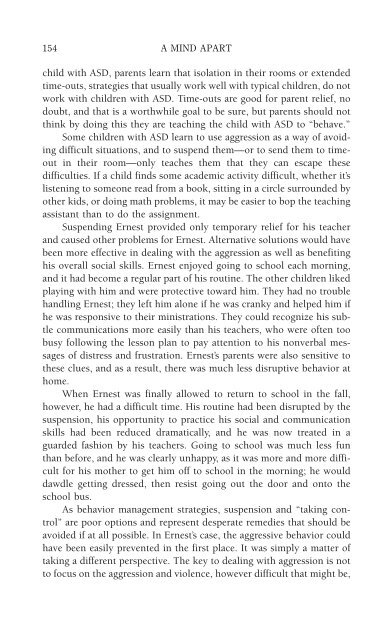978-1572305441
autism
autism
Create successful ePaper yourself
Turn your PDF publications into a flip-book with our unique Google optimized e-Paper software.
154 A MIND APART<br />
child with ASD, parents learn that isolation in their rooms or extended<br />
time-outs, strategies that usually work well with typical children, do not<br />
work with children with ASD. Time-outs are good for parent relief, no<br />
doubt, and that is a worthwhile goal to be sure, but parents should not<br />
think by doing this they are teaching the child with ASD to “behave.”<br />
Some children with ASD learn to use aggression as a way of avoiding<br />
difficult situations, and to suspend them—or to send them to timeout<br />
in their room—only teaches them that they can escape these<br />
difficulties. If a child finds some academic activity difficult, whether it’s<br />
listening to someone read from a book, sitting in a circle surrounded by<br />
other kids, or doing math problems, it may be easier to bop the teaching<br />
assistant than to do the assignment.<br />
Suspending Ernest provided only temporary relief for his teacher<br />
and caused other problems for Ernest. Alternative solutions would have<br />
been more effective in dealing with the aggression as well as benefiting<br />
his overall social skills. Ernest enjoyed going to school each morning,<br />
and it had become a regular part of his routine. The other children liked<br />
playing with him and were protective toward him. They had no trouble<br />
handling Ernest; they left him alone if he was cranky and helped him if<br />
he was responsive to their ministrations. They could recognize his subtle<br />
communications more easily than his teachers, who were often too<br />
busy following the lesson plan to pay attention to his nonverbal messages<br />
of distress and frustration. Ernest’s parents were also sensitive to<br />
these clues, and as a result, there was much less disruptive behavior at<br />
home.<br />
When Ernest was finally allowed to return to school in the fall,<br />
however, he had a difficult time. His routine had been disrupted by the<br />
suspension, his opportunity to practice his social and communication<br />
skills had been reduced dramatically, and he was now treated in a<br />
guarded fashion by his teachers. Going to school was much less fun<br />
than before, and he was clearly unhappy, as it was more and more difficult<br />
for his mother to get him off to school in the morning; he would<br />
dawdle getting dressed, then resist going out the door and onto the<br />
school bus.<br />
As behavior management strategies, suspension and “taking control”<br />
are poor options and represent desperate remedies that should be<br />
avoided if at all possible. In Ernest’s case, the aggressive behavior could<br />
have been easily prevented in the first place. It was simply a matter of<br />
taking a different perspective. The key to dealing with aggression is not<br />
to focus on the aggression and violence, however difficult that might be,



